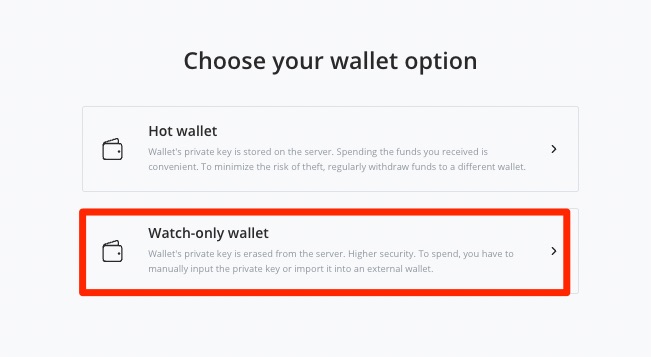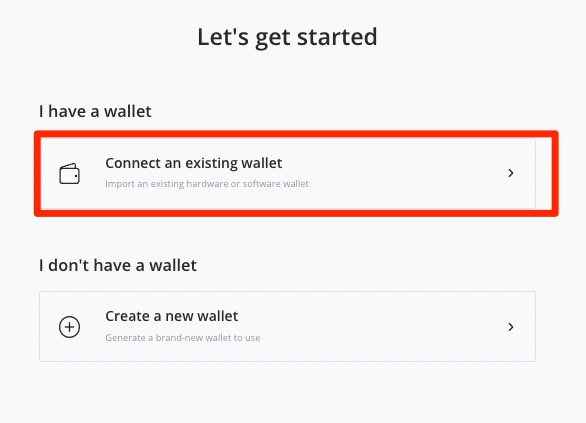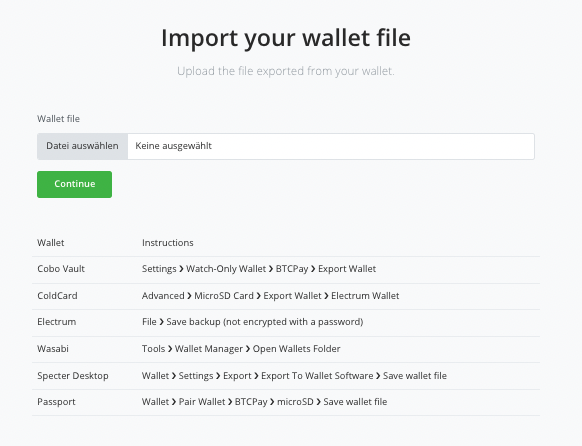BTCPay Bitcoin Wallet
Als Betreiber eines BTCPay Stores möchte man Bitcoin empfangen. Diese eingehenden Bitcoin werden auf einer Bitcoin Wallet gutgeschrieben.
Entsprechend muss der Betreiber eines BTCPay Stores in diesem Store hinterlegen, wo die eingehenden Bitcoin gutgeschrieben werden sollen.
Bei der Einrichtung eines BTCPay Store, ist dies eine der wesentlichen Einstellungsmerkmale.
Es gibt dafür verschiedene Optionen, welche wir in diesem Beitrag näher vorstellen wollen.
YouTube Video: Hinterlegen einer Bitcoin Wallet bei einem BTCPay Server
Über den Beitrag, „Hinterlegen einer Bitcoin Wallet bei einem BTCPay Server“ gibt es ein deutschsprachiges Erklärvideo auf dem Coincharge YouTube Kanal.
Merkmale einer BTCPay Bitcoin Wallet
Jeder BTCPay Store verfügt über eine eigene Bitcoin Wallet. Wer auf einem BTCPay Server mehrer BTCPay Store betreibt, muss für jeden BTCPay Store eine eigene Bitcoin Wallet hinterlegen.
Dies hat den Vorteil, dass man die Bitcoin Eingänge für jeden BTCPay Store separat verwalten kann.
Ein weiteres wichtiges Merkmal ist, dass die Bitcoin Wallet immer einer Eigenverwahrung (Self-Custody) unterliegen.
Ausschliesslich der Eigentümer des BTCPay Store mit seiner eigenen Bitcoin Wallet hat Zugriff auf die Bitcoin und nicht der Betreiber oder Administrator des BTCPay Servers. Dies ist besonders dann von Bedeutung, wenn man keinen eigenen BTCPay Server betreibt, sondern einen BTCPay Server mitbenutzt.
interne BTCPay Bitcoin Wallet vs. externe Bitcoin Hardware Wallet
Man hat die Möglichkeit, sich eine eigene Bitcoin Wallet auf dem BTCPay Server neu erstellen zu lassen oder eine bereits bestehende Bitcoin Wallet zu verwenden.
Der sicherste Weg, um sein lanfristig gespartes Bitcoin Guthaben aufzubewahren, ist eine eigene Hardware Bitcoin Wallet.
Für die tägliche Arbeit kann es aber sinnvoll sein, die eingehenden Bitcoin Zahlungen nicht direkt in seine sichere Spardose („Bitcoin Hardware Wallet“) eingehen zu lassen, sondern einen Zwischenschritt über die interne BTCPay Bitcoin Wallet zu nehmen.
Die Verwendung der internen BTCPay Bitcoin Wallet ist ist die komfortableste und einfachste Lösung, bei der Verwendung einer Bitcoin Wallet. Man verzichtet auch auf keine Sicherheit, da man einen eigenen Seed erhält und somit jederzeit Zugriff auf sein Bitcoin Guthaben behält.
Eine kleines Bitcoin Guthaben auf der internen BTCPay Bitcoin Wallet ist empfehlenswert, wenn man als Händler Auszahlungen für die Gewährung von Gutschriften oder Erstattungen vornehmen will.
Möchte man die eingehenden Bitcoin Zahlungen nicht selber behalten, sondern zeitnah bei einer Bitcoin Börse verkaufen, ist die Verwendung der internen BTCPay Bitcoin Wallet sinnvoll. Per Transmuter lassen sich diese eingehenden Bitcoin Einnahmen dann an die Bitcoin Adresse der Bitcoin Börse weiterleiten.
Wer die eingehenden Bitcoin Ümsätze behalten möchte, sollte sich für die sicherste Variante entscheiden und die eingehenden Bitcoin Umsätze direkt auf seine Bitcoin Hardware Wallet gutschreiben lassen.
Wer am Anfang erst einmal ausprobieren möchte oder nicht sofort mit wesentlichen Bitcoin Umsätzen rechnet, die einen sofortigen Erwerb einer Bitcoin Hardware Wallet rechtfertigen, dem empfehlen wir den Einstieg mit der internen BTCPay Bitcoin Wallet und ein Wechseln auf eine externe Bitcoin Hardware Wallet zu einem späteren Zeitpunkt.
Wenn wir ein BTCPay Store erstellt haben, erfolgt die Aufforderung, dass wir eine neue Bitcoin Wallet erstellen („Set up a wallet“) sollen.
Die Administration und Einrichtung der Bitcoin Wallet können wir zu jedem Zeitpunkt auch über den Menüpunkt Wallet direkt aufrufen.
Wir beginnen mit dem Set up a wallet.
Erstellen einer internen BTCPay Bitcoin Wallet
Wir beginnen in der Anleitung mit der Erstellung einer neuen Bitcoin Wallet. Im Anschluss erfolgt die Anleitung, wenn man bereits über eine eigene Bitcoin Wallet verfügt.
Wir wählen aus, dass wir über keine Wallet verfügen und eine neue Wallet erstellen wollen („Create a new wallet“).
Hot Wallet vs. Watch-Only Wallet
Hot Wallet
Wir beginnen mit der Erstellung einer Hot Wallet.
Bei der Erstellung einer Hot Wallet, verbleiben die Privaten Schlüssel auf dem Server gespeichert.
Dies ist sehr komfortabel, wenn man die erhaltenen Bitcoin Beträge über diese Wallet wieder ausgeben möchte.
Um das Risiko zu minimieren, wird empfohlen, dieses Bitcoin Guthaben regelmäßig auf eine andere Wallet zu transferieren.
Nachdem man die Erstellung einer Hot Wallet ausgewählt hat, wird man mit der Frage des Address Type konfrontiert.
Mit dem Address Type wird festgelegt, welche Bitcoin Adresse erstellt wird, die dem Zahler angezeigt werden soll.
Die Entscheidung nach dem Address Type richtet sich also danach, welche Bitcoin Wallet von den Kunden verwendet wird.
Es empfiehlt sich den vorgeschlagenen Address Type Segwit zu verwenden. Dies ist mittlerweile der etablierte Standard und wird von allen modernen Bitcoin Wallet unterstützt.
Die Payjoin Funktion sollte aktiviert bleiben. Es bietet Kunden und Händlern eine höhere Privatsphäre bei der Bezahlung.
Man erhält dann den Recovery Phrase für seine Bitcoin Wallet angezeigt. Es handelt sich dabei um 12 Wörter, die man sich an einen sicheren Ort speichert.
Mit diesen 12 Wörtern hat man jederzeit Zugriff auf sein Bitcoin Guthaben. Auch dann, wenn man keinen Zugriff auf den Server mehr hat.
Nachdem man sich die Wörter notiert hat, bestätigt man dies mit dem Setzen des Häkchen und klickt auf Done.
Watch-Only wallet
Bei der Verwendung einer internen BTCPay Wallet als Watch-Only Wallet wird nach der Erstellung der Wallet, der private Schlüssel vom Server gelöscht. Bei der Hot Wallet Version verbleibt der Private Key auf dem Server.
Watch-Only bedeutet, dass man auf seiner Bitcoin Wallet Zahlungen empfangen kann und sich diese Umsätze und das Guthaben auch ansehen kann. Es können aber selber keine Zahlungen ausgeführt werden. Über das Guthaben können keine Verfügungen vorgenommen werden.
Verfügungen sind nur dann möglich, wenn der Private Schlüssel vorliegt. Der bleibt bei dieser Variante aber nicht auf dem Server liegen, sondern wird entfernt.
Dadurch, dass der Private Key vom Server entfernt wird, ergibt sich eine höhere Sicherheit. Hat allerdings den Nachteil, dass wenn man das Bitcoin Guthaben transferieren will, der private Key für jede Zahlung eingegeben bzw. importiert werden muss.
Die Watch-Only Variante ist zu empfehlen, wenn neben dem Store Eigentümer, weitere Personen wie Buchhaltung oder Administrator Zugriff auf den BTCPay Store haben.
Handelt es sich nicht um einen eigenen BTCPay Server, sondern wird ein BTCPay Server mitbenutzt, sollte man sich ebenfalls für diese Waltch-Only Wallet entscheiden.
Nachdem man die Erstellung einer Watch-Only Wallet ausgewählt hat, muss man sich für einen Address Type entscheiden.
Es empfiehlt sich den vorgeschlagenen Address Type Segwit zu verwenden.
Ebenso sollte die Payjoin Funktion aktiviert bleiben.
Man erhält dann den Recovery Phrase für seine Bitcoin Wallet angezeigt.
Bei der Watch-Only Wallet ist es zwingend erforderlich, dass die 12 Wörter notiert werden, da dieser Private Schlüssel vom Server entfernt wird und es keinen späteren Zugriff mehr möglich ist.
Diese 12 Wörter werden immer dann benötigt, wenn man über sein Bitcoin Guthaben verfügen möchte.
Nachdem man sich die Wörter notiert hat, bestätigt man dies mit dem Setzen des Häkchen und klickt auf Done.
Die Erstellung einer Watch-Only Wallet ist identisch mit der Erstellung einer Hot Wallet.
Der Unterschied ergibt sich bei der späteren Verwendung. Möchte man Verfügungen über seine interne BTCPay Bitcoin Wallet vornehmen, so ist dies bei der Hot Wallet mit einem Klick möglich.
Bei der Watch-Only Wallet muss bei jeder Auszahlung die 12 Wörter des Privaten Schlüssels eingegeben werden.
Dadurch erhöht sich die Sicherheit vor einem unerlaubten Transferieren der Bitcoin. Dies Sicherheit geht allerdings zu Lasten des Komfort.
Bestehende Bitcoin Wallet verwenden
Verfügt man bereits über eine Bitcoin Wallet, so kann diese bestehende Bitcoin Wallet bei seinem BTCPay Store hinterlegt werden.
Hardware Wallet verbinden
Import Wallet file
Aus einer bestehenden Bitcoin Wallet wird das Wallet File exportiert und an dieser Stelle eingefügt.
Extended Public Key (xPub Key)
Eine weitere Option bietet die Integration eines xPub Key. Die Abkürzung xPub Key steht für extended public key und bedeutet erweiterter öffentlicher Schlüssel.
Ein normaler öffentlicher Schlüssel ist eine Bitcoin Adresse, welche weitergegeben wird, damit darauf Bitcoin Zahlungen vorgenommen werden können.
Der xPub Key dient der Erstellung von unendlich vielen Bitcoin Adressen die weitergegeben bzw. für die Zahlungsabwicklung verwendet werden können.
Im Gegensatz zu dem Private Key, kann der Public Key weitergegeben werden.
An dieser Stelle wird der Extended Public Key (xpub Key) hinterlegt.
Bei dem Einfügen muss zusätzlich noch der Adress Typ angehängt werden.
Der Adress Typ ist davon abhängig, was Du bei der Erstellung Deiner Bitcoin Wallet festgelegt hast.
| bc1….. | P2WPKH, Bech32 Adresse | |
| 3….. | P2SH-P2WPKH | -[p2sh] |
| 1….. | P2PKH | -[legacy] |
Abhängig vom Script Typ muss an den xpub Key der Zusatz, inklusive Bindestrich und Klammer, angehängt werden.
Wir empfehlen die Verwendung einer Bech32 Adresse mit dem Script Type p2wpkh. Entsprechend ist ein Zusatz nicht erforderlich.
Wie man den xPub Key auf seiner Bitcoin Hardware Wallet (BitBox, Ledger, Trezor) findet, haben wir in einem separaten Beitrag ausführlich beschrieben: Wo finde ich den xPub Key von meinem Wallet?
Für die Nutzer einer Electrum Wallet oder eines Raspiblitz gibt es ebenfalls eigenständige Anleitungen.
QR Code scannen
Mit dem scanne eines QR Code gibt es eine komfortable Möglichkeit, um einen xPub Key zu importieren.
Auf der Bitcoin Wallet wird dann der xPub Key als QR Code angezeigt, der dann über die Kamera des eigenen Computers gescannt und bei dem entsprechenden BTCPay Store hinterlegt wird.
Für das Scannen des QR Code ist es erforderlich, dass man an seinem Computer eine Kamera hat und dieser Kamera die Berechtigung einräumt, dass der Webbrowser darauf zugreifen darf.
Es gibt mehrer Bitcoin Wallet, bei denen man sich den xPub Key per QR Code anzeigen lassen kann.
Wie man diese Einstellung bei den entsprechenden Bitcoin Wallet findet, wird kurz erklärt.
Wie man den xPub Key von der BlueWallet per QR Code scannt und bei seinem BTCPay Store hinterlegt, wurde in der Beschreibung der BlueWallet beschrieben.
Wallet Seed
In den vorangegangenen Erklärungen, wurde immer der Öffentliche Schlüssel („Public Key“) importiert.
Bei dem Importieren des Wallet Seed wird der Private Schlüssel importiert, aus dem dann der erforderliche Public Key abgeleitet wird.
Da der Public Key niemals weitergegeben werden sollte, ist diese Vorgehensweise nicht zu empfehlen.
In das Feld Wallet Recovery Seed werden die 12 beziehungsweise 24 Wörter des Recovery Seed eingegeben.
Eine Verwendung des Recovery Seed kann dann sinnvoll sein, wenn man eine eine interne BTCPay Hot Wallet erstellt hat und diese Bitcoin Wallet wieder herstellen möchte.
Zusammenfassung
Es gibt eine Vielzahl von Möglichkeiten, um eine Bitcoin Wallet bei seinem BTCPay Store zu hinterlegen.
Durch die Vielzahl der Möglichkeiten kann man schnell den Überblick verlieren. Jede dieser Optionen bietet individuelle Vorteile, die sich je nach den Bedürfnissen der Store Eigentümers richten.
Wer kleinere Umsätze erwartet und nur einmal ausprobieren möchte, für den wird die interne BTCPay Bitcoin Hot Wallet vollkommen ausreichend sein.
Wer größere Umsätze erwartet und entsprechend sehr viel Wert auf Sicherheit legen wird, der wird an eine externe Bitcoin Wallet nicht herum kommen. Hier empfiehlt sich die Integration des xPub Key. Wie der Import des xPub Key erfolgt, dürfte abhängig davon sein, welche Art von externer Bitcoin Wallet verwendet wird.
























Leave a Reply
Your email is safe with us.